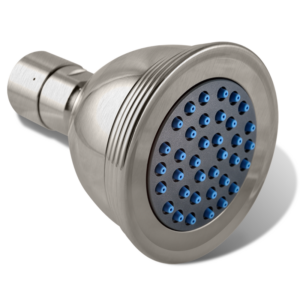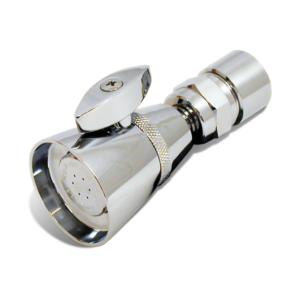RVs and BUSES | MARINE | OFF GRID – SOLAR | 240V | DIESEL | ENGINE
For a printable PDF version of this post Click Here or to view relevant products Click Here.
Dieselheat has developed a range of systems to create eco-friendly solar hot water by utilising surplus capacity in your existing solar system and then boosting with a diesel furnace when the sun isn’t shining or you need to run optional air heating.
Our systems use SureCal copper calorifiers (hot water tanks) and connect to your existing solar system, engine (for boats), diesel furnace or 240V when available to provide hot water and optional air heating in a space-efficient integrated system.
Please note, these systems are not plug and play – they require assembly, some technical knowledge, some extra electrical parts for the solar diverter and also an existing solar system.
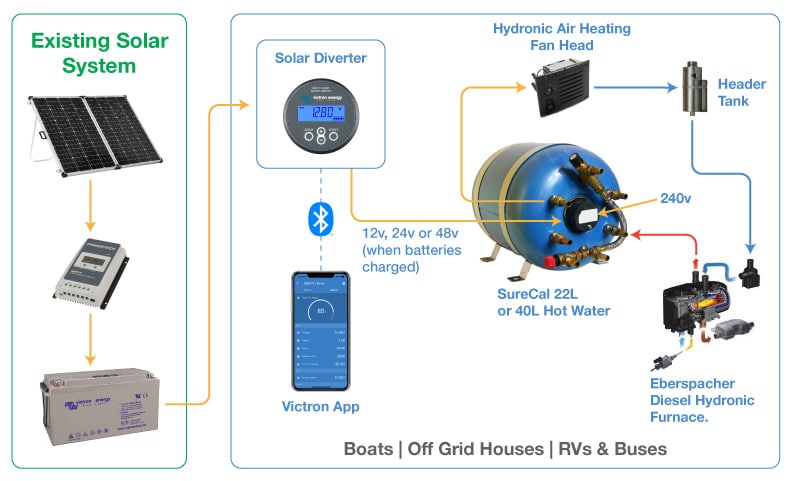
System Benefits
- Water is heated automatically using surplus solar power.
- The high power diesel furnace (5kW) will reheat the system rapidly if a lot of hot water (e.g. multiple showers) is needed.
- The system stores either 22L or 40L of hot water, so as long as the tank is heated, hot water is available all the time without needing to turn on the system. This suits those living aboard or off grid, as well as travellers who may want hot water at any time of the day.
- Optional 240v water heating suits RV and boat installations.
SureCal Tanks
The SureCal tanks imported from the UK by Dieselheat are a high quality copper tank with 2 hydronic heating coils and the option for dual electric elements, making them the most versatile tank on the market. In addition, the copper construction allows very efficient heat transfer from the diesel furnace to the water in the tank, ensuring rapid heating and minimising excessive diesel furnace cycling.
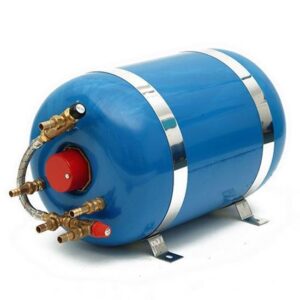
System Designs
Typical systems will include a SureCal 22L (or 40L) hot water tank with either a pure low voltage element (for off grid houses and some RVs) or a combined 12V/240V element (for boats and RVs). This is then augmented using a diesel furnace that heats a coolant loop including a pump (which is part of the furnace), the SureCal tank, a header tank and optional air heating accessories. On boats, the second heating loop on the SureCal tank can then be connected to the engine.
Solar
The system utilises excess capacity in an existing solar system to heat hot water once the batteries are fully charged. This is done using a solar diverter to divert power from the solar panels when your batteries are charged. If the batteries start to lose their charge, the diverters cut out the heating element to ensure the batteries remain fully charged. This system operates directly on the battery system at 12, 24 or 48 volts.
Our solar electric heating options all operate at sensible power levels to keep electrical current levels at or below 25A and allow our 22L or 40L tanks to be fully heated on a typical sunny day. Available elements include:
- 12V (300W) / 240V(1000W) combined
- 12V (200W)
- 24V (600W)
- 48V (600W)
We do not recommend connecting the 1000W 240V element to an inverter, as this power level will draw 85A from the battery at 12V, which is a significant load requiring very large batteries and cabling.
View the full range of solar and 240v elements here.
Solar System Setup
Generally, the bigger the solar system the more solar hot water you get. The best results are achieved when the capacity of the solar panels is at least double the power of the heating element. So if you have a 300W heating element, ideally have at least 600W of solar power. This is because your solar panels won’t always generate their rated capacity and having double the needed power gives the heating element a good chance of staying on all the time when it is a sunny day.
The system will only work well if you have good quality, brand name solar panels and charge controllers and sufficiently heavy wiring. Cheap ‘Ebay’ controllers and panels do not deliver their rated outputs and will often be unable to deliver the required power to effectively heat your water.
Solar Heating Times
The heating times shown in the table below are theoretical continuous heating times based on the assumption that the solar system is providing the required power to keep the element on full time. If the solar system cannot do this, the element will cycle, so heating times will extend. Heating times are based on a starting temperature of 20°C and ending temperature of 60°C in the tank.
Element
22L Tank
40L Tank
200W 12V
5.5h
9.3h
300W 12V
3.4h
6.2h
600W 24V/48V
1.7h
3.1h
Actual heating of the water depends on the capacity of your solar system, the distance from the batteries to your tank (due to power losses in wires), the weather and hours of sunlight, your battery capacity and other factors. Because we can’t guarantee the sun will shine all day every day, we always suggest having a diesel furnace as backup.
Solar Diverter
To heat water using solar power, you need a diverter that will send surplus power from your solar panel to the low voltage heating element when the batteries are fully charged. If the solar system makes more power than the element consumes, the element stays on. However, if the sun goes behind a cloud or the solar panels can’t keep up with the element, the diverter needs to turn off the element once the batteries start to discharge.
Many newer solar charge controllers have programmable relays that can be programmed to turn on a relay when the batteries are fully charged and switch it off when the batteries drop to say 95%.
If your solar system does not have a programmable relay, you can make a simple solar diverter using a Victron Energy battery monitor such as the BMV-712. This monitor is bluetooth enabled to allow easy programming and has a built-in relay that can be programmed to act as a solar diverter.
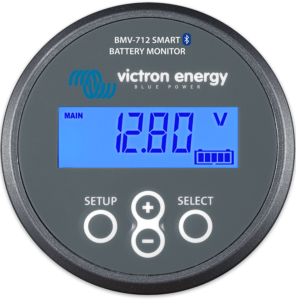
Note: All low voltage elements use approximately 20 – 25A, so they must be switched with a dedicated 25A relay. Do not use the relay inside the battery monitor or the thermostats supplied with the heating elements to switch the actual element directly.
Dieselheat has tested the following configuration and wiring to use the BMV-712 as a solar diverter
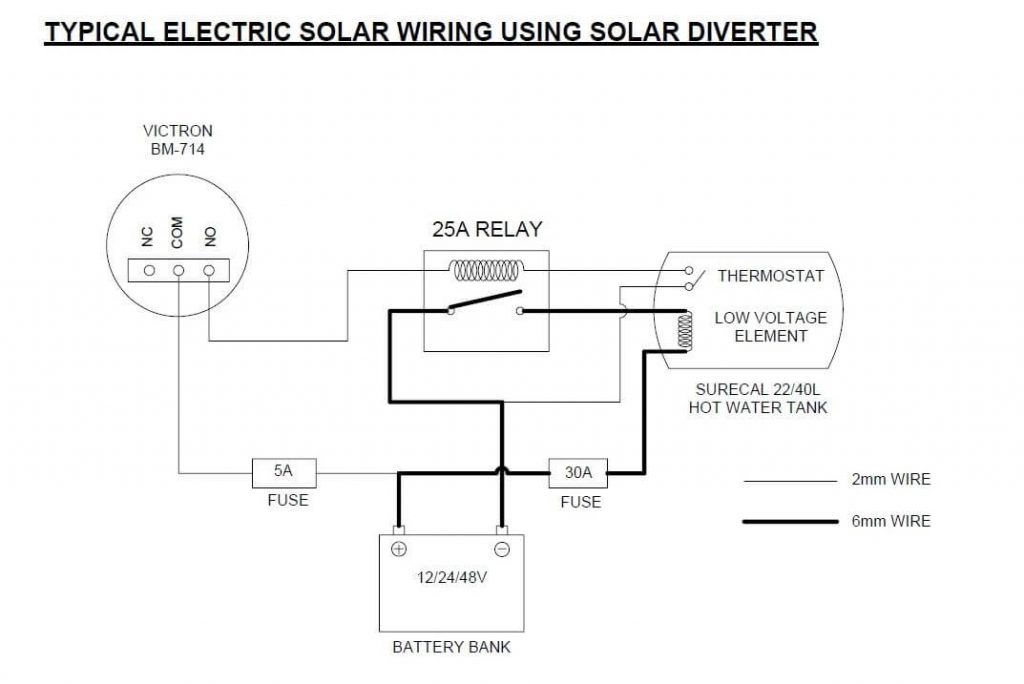
Notes:
- The fuses should be located close to the battery.
- We suggest using the normally open contact in the BM-712 relay, as this will ensure the heating element defaults to off if the BM-712 fails or loses contact with the battery shunt, etc..
- Use minimum automotive 6mm cable for all parts of the heating element circuits and keep the high current wiring length to a minimum. If your cable runs are longer than 3-4m, you should consult a wiring gauge table to size the cables properly.
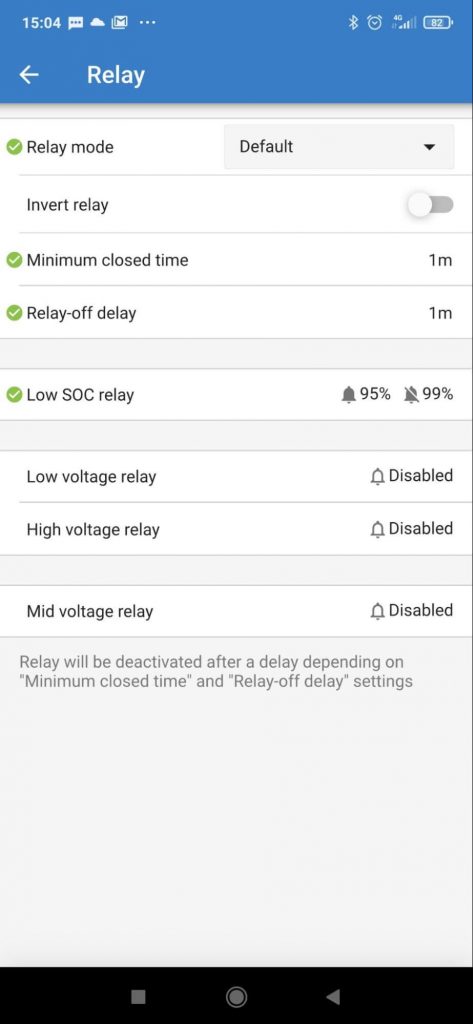
The relay setting for the BMV-712 in the Victron Connect App can be set as shown in the image to allow the system to heat the hot water when the batteries hit 99% and to cut out when they drop to 95%. Depending on your batteries and solar, you may wish to vary the turn off point. However, it is suggested to keep it quite high to minimise ‘working’ the batteries as the system cycles.
Diesel
On days when your batteries do not fully charge or when you need extra hot water, the system can be heated using a diesel booster. The diesel booster can also be used to run optional hydronic air heating. For these systems, we use the premium Eberspacher D5E 1.3kW – 5kW hydronic furnace, the quietest and smoothest furnace on the market.
The diesel furnace pumps engine coolant through a closed loop using its own supplied pump. The system is filled via a header tank, which allows for thermal expansion of the coolant and for bleeding out any air. The header tank always has to be located at the highest point in the system.
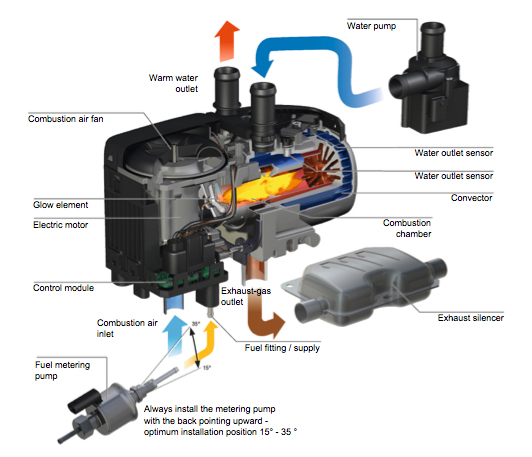
As noted below, the final layout of the system depends on the location of all the items in the RV/boat/house and also on how many air heating accessories will be connected to the hydronic system.
Smaller, simpler systems use a single pipe loop with everything in series. Note that the fan heads need bypass valves to ensure that if they have the coolant turned off, they do not stop coolant flow in the main loop.
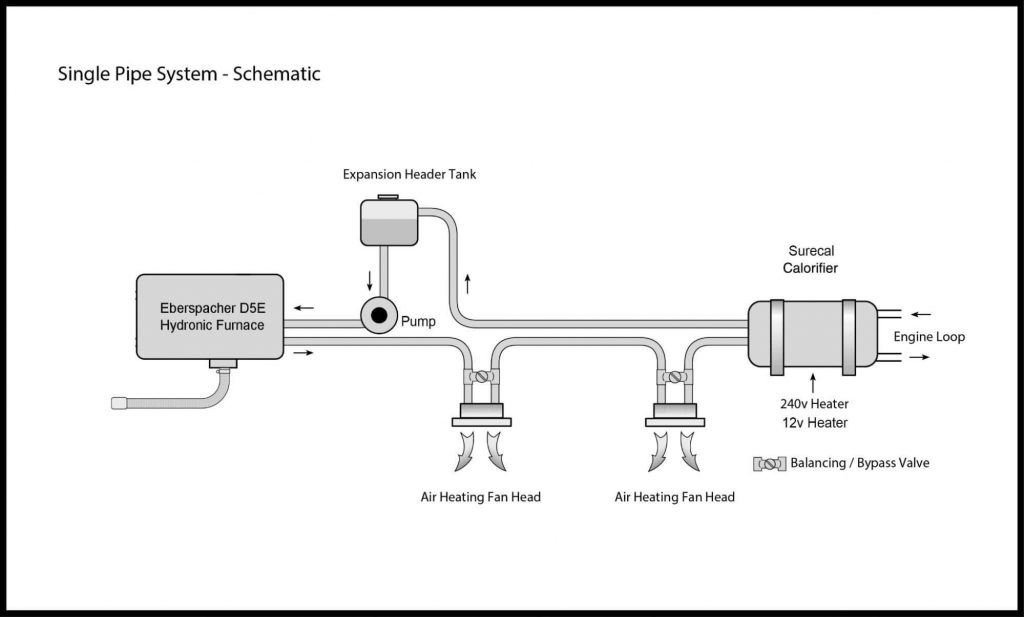
Larger systems have double or parallel pipes and each hydronic item sits across the pipes in parallel. Each item needs its one flow control valve to allow balance of the entire system.
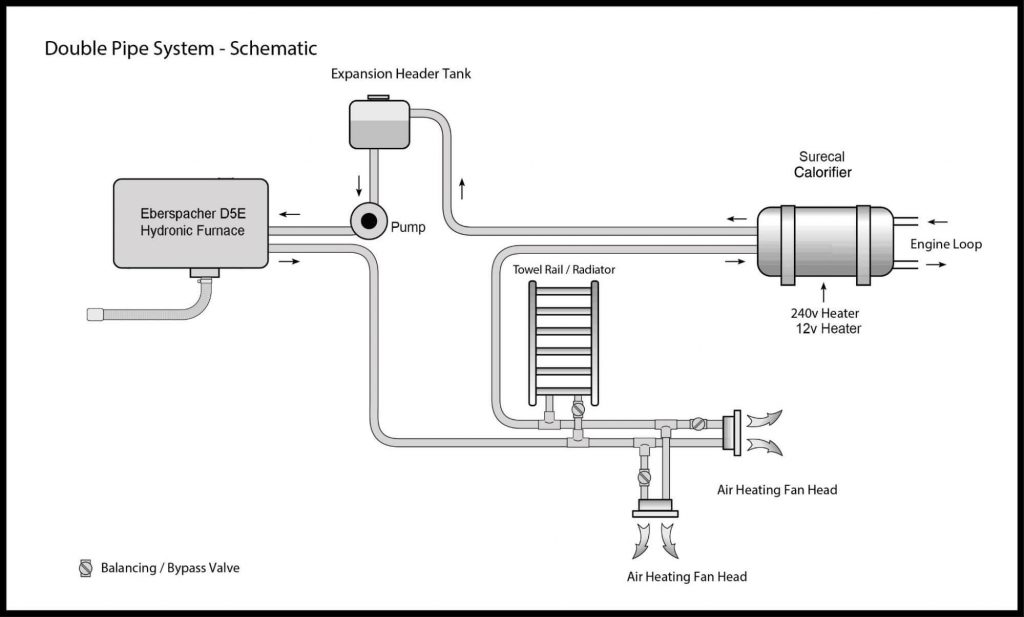
240V Elements
The system can have an optional 240V element (beside the solar element) to allow heating when on mains power. This works well for RVs and boats when a mains connection is sometimes available. SureCal tanks and the supplied 240v elements have been certified for use in Australia, but these must be installed by a qualified electrician.
Optional Air Heating
For boats and RVs, adding a Kalori fan head is a good option if you require air heating. This will convert the system into an effective air heater capable of giving off up to 5kW of air heating from a range of Kalori fan heads.
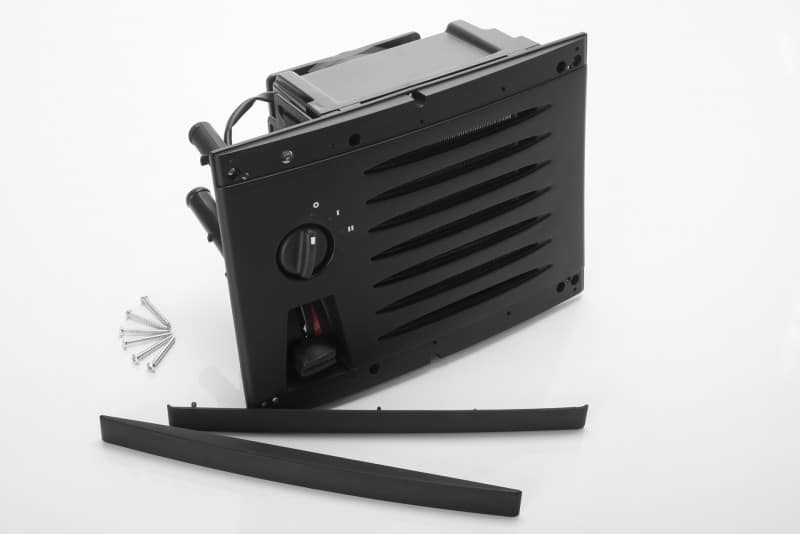
For off grid houses and classic wooden boats, panel radiators and hydronic towel rails can also be utilised. These have the advantage of being totally quiet, but need more space as heat output per m² of radiator is lower.
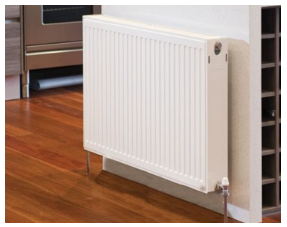
Finally, if you are mobile and need to conserve water but still want a great shower, our Bricor shower heads in either 2L/min or 4.5L/min give the most satisfying shower at a low flow rate.
